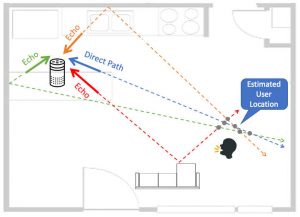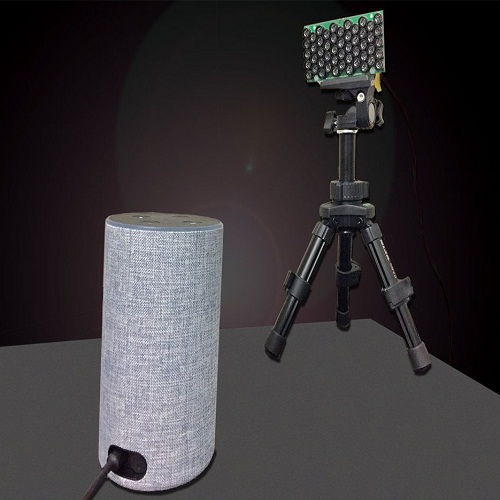A smart speaker can be used to locate you within a room, with no prior knowledge of room shape, according to a University of Illinois at Urbana-Champaign research team. It also, at lease partially, maps the room.
 It uses the microphone array in the speaker, an Alexa in this case, to provide data for an algorithm that identifies direct and reflected sound paths, then reverse-triangulates to calculate a position.
It uses the microphone array in the speaker, an Alexa in this case, to provide data for an algorithm that identifies direct and reflected sound paths, then reverse-triangulates to calculate a position.
“Applying this technique to smart speakers entails quite a few challenges,” said team engineer Sheng Shen. “First, we must separate the direct human voice and each of the room echoes from the microphone recording. Then, we must accurately compute the direction for each of these echoes. Both challenges are difficult because the microphones simply record a mixture of all the sounds altogether.”
Key to the method was the observation that a wall near the microphone array will provide a stable ever-present echo. If the wall’s distance and orientation can be estimated with respect to the microphones, then the echo’s angle of arrival and delay become a function of subject’s location.
“Under modest assumptions, we report localization accuracy of 0.44m across different rooms, clutter, and user and microphone locations,” according to ‘Voice localization using nearby wall reflections‘ (available in full), a paper to be presented at the Annual International Conference on Mobile Computing and Networking (MobiCom 2020) in London in September. The algorithm runs in near-real-time, but needs to hear ~15 voice commands to work.
The technique has been branded VoLoc.
“Our next step is to build to the smart speaker’s frame of reference,” said Shen. “This could mean superimposing the locations, as provided by VoLoc, on a floorplan to determine that the user is in the laundry room. Alternatively, if the smart speaker picks up the sounds made by the washer and dryer in the same location as the voice command, it can come to the same conclusion.”
Privacy
Shen and fellow researcher Romit Roy Choudhury acknowledge that the technique could erode privacy, “by allowing companies like Amazon and Google to peer more closely into our homes and daily lives”.
Their response is that its benefits could be important, for example, to less-able people – reminding someone to take medicine as they pass their medicine cabinet, or reminding a child to return and turn a tap off that they have left running as they leave a bathroom.
“It’s more than interpreting voice commands,” said Shen. “It provides an extra set of eyes.”
Source: electronicsweekly










